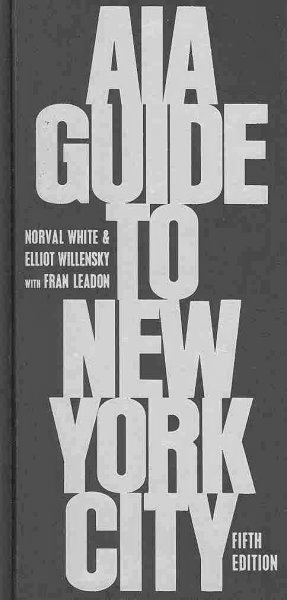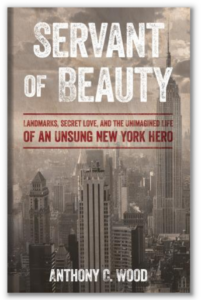
Elliot Willensky
Though he started his career in architecture, Elliot Willensky became a prominent figure in the New York City historic preservation field during the 1960s, 1970s, and 1980s. He participated in both governmental and grassroots efforts, which ranged from serving on the Landmarks Preservation Commission to organizing and participating in protests to save the old Pennsylvania Station.
Elliott Willensky was born and raised in Brooklyn, New York. He received a certificate in architecture from The Cooper Union and a Masters of Architecture from Yale University. In 1955, he began his career at the architecture firm of Lathrop Douglass, where he met Norval White.1 In 1962, Willensky and White founded the Action Group for Better Architecture in New York (AGBANY), a coalition of young, modern architects united against the demolition of McKim, Mead and White’s Pennsylvania Station (1910).
Willensky co-authored the first edition of the AIA Guide to New York City with Norval White. The original AIA Guide was created for the 1967 AIA convention in New York City and was self-published. Beginning that year, Willensky also held a number of important posts in New York City. From 1968 to 1971, he was Deputy Administrator and Director of Design for the New York City Parks, Recreation and Cultural Affairs Administration. For the next five years, Willensky headed the High Rock Park Environmental Education Center on Staten Island. In 1979, he was appointed to the New York City Landmarks Preservation Commission and in 1985 he became its Vice Chairman. Willensky also served as director of the 34th Street Midtown Association.
As the official Borough Historian of Brooklyn, Willensky also wrote a popular history, ”When Brooklyn Was the World, 1920-1957,” published in 1986. Elliot Willensky passed away on May 25, 1990 at the age of 56.
- NYC Parks, Recreation, and Cultural Affairs Administration
- Deputy Administrator/Director of Design, (1968-1971)
- NYC Landmarks Preservation Commission (1979-1985)
- Commissioner, (1979-1985)
- NYC Landmarks Preservation Commission
- Vice Chairman, (1985-1990?)
- 34th Street Midtown Association
- Director
- Borough Historian, Brooklyn
In 1961, a building at 98 Cranberry Street in Brooklyn Heights, the former Rome Printing Shop where Walt Whitman first printed Leaves of Grass (1855), was threatened with demolition.2 The Title 1 Cadman Plaza urban renewal project sought to remove the entire block where this house was situated in Brooklyn Heights.3 Elliot Willensky joined others, including poet Allen Ginsberg and local groups like the North Heights Community Group and the Central Brooklyn Heights Group for Preservation and Improvement, to preserve the building in what would be one of his first historic preservation battles. Willensky noted that the group he joined was focused on the single issue of the Walt Whitman-related site, rather than on the whole area that the Cadman Plaza project threatened.4 Willensky, however, argued that the row of buildings should be saved instead of isolating the Walt Whitman building - an idea that was not a priority for others trying to save the structure.5
The Housing and Redevelopment Board denied the civic activists the preservation of the building on site and instead offered permission to move the building to another location, without allocating city funds to do so.6
In 1962, Elliot Willensky, along with Norval White and other young architects, founded the Action Group for Better Architecture in New York (AGBANY). He was part of a new generation of architects that Anthony C. Wood referred to as “young turk architects”.7 These young architects came together to form AGBANY when the pending demolition of Penn Station was announced. Willensky noted that he was drawn to Penn Station because "...[Penn Station] was a building whose presence had made itself important in the lives of millions of people and was a symbol of the city."8
In August 1962, AGBANY organized a picket line in front of Penn Station that attracted a great deal of public attention.9 The picket line was made up of the young generation of architects like Elliot Willensky and other more established individuals in the field such as Peter Blake, I.M. Pei, and Philip Johnson.10
The protest did not save Penn Station, but rather intensified the battle on its behalf. In January 1963, AGBANY again made a public appearance in favor of saving Penn Station. A public hearing was held by the City Planning Commission for a variance that the project needed to move forward with the demolition.11 At that hearing, Elliot Willensky and many other members of AGBANY spoke in support of preserving Penn Station.12 Ultimately, AGBANY was unsuccessful in the battle to save Penn Station and demolition began in the fall of 1963.13
In 1979, Elliot Willensky was appointed to the New York City Landmarks Preservation Commission. In 1985, he became its Vice Chairman.14 During his tenure as a commissioner, the Landmarks Preservation Commission extended protections to many important buildings in New York City including the Empire State Building, Lever House, the Apollo Theatre, the Woolworth Building and Rockefeller Center.15
Wood, Anthony C. “Interview with Commissioner Elliot Willensky” 3 Feb 1988. For transcript contact info@nypap.org. New York Preservation Archive Project 174 East 80th Street New York, NY 10075. Tel: (212)988-8379, Fax: (212)537-5571, www.nypap.org
- Wood, Anthony C. “Interview with Commissioner Elliot Willensky.” 3 Feb 1988.
- Arnold, Martin. “City is Attacked on Cadman Plaza,” New York Times. September 20, 1961.
- Wood, Anthony C. Preserving New York: Winning to the Right to Protect a City’s Landmarks. New York: Routledge, 2008.
- Wood, Anthony C. Interview with Commissioner Elliot Willensky. February 3, 1988.
- Ibid.
- “City Permits Saving Walt Whitman Site in Brooklyn Project,” New York Times. December 4, 1962.
- Wood, Anthony C. Preserving New York: Winning to the Right to Protect a City’s Landmarks. New York: Routledge, 2008.
- Wood, Anthony C. Interview with Commissioner Elliot Willensky. February 3, 1988.
- Ibid.
- Ibid.
- Gray, Christopher. “On Preservation, I Told You So,” New York Times. July 12, 1992.
- Wood, Anthony C. Interview with Commissioner Elliot Willensky. February 3, 1988.
- Gray, Christopher. “On Preservation, I told You So,” New York Times. July 12, 1992.
- Dunlap, David W. “Elliot Willensky, Writer of Guide to New York Buildings, Dies at 56,” New York Times. May 27, 1990.
- www.neighborhoodpreservationcenter.org




